How were conditions on the early Earth of more than 3 billion years ago different from those on today's Earth?
- A) Only early Earth was intensely bombarded by large space debris.
- B) Only early Earth had an oxidizing atmosphere.
- C) Less ultraviolet radiation penetrated early Earth's atmosphere.
- D) Early Earth's atmosphere had significant quantities of ozone.
A
Which of the following is the correct sequence of events in the origin of life?
- formation of protobionts
- synthesis of organic monomers
III. synthesis of organic polymers
- formation of DNA-based genetic systems
- A) I, II, III, IV
- B) I, III, II, IV
- C) II, III, I, IV
- D) II, III, IV, I
C
Which of the following is a defining characteristic that all protobionts had in common?
- A) the ability to synthesize enzymes
- B) a surrounding membrane or membrane-like structure
- C) RNA genes
- D) the ability to replicate RNA
B
The first genes on Earth were probably
- A) DNA produced by reverse transcriptase from abiotically produced RNA.
- B) DNA molecules whose information was transcribed to RNA and later translated in polypeptides.
- C) self-replicating RNA molecules.
- D) antibiotic resistant.
C
Several scientific laboratories across the globe are involved in research concerning the origin of life on Earth. Which of these questions is currently the most problematic and would have the greatest impact on our understanding if we were able to answer it?
- A) How can amino acids, simple sugars, and nucleotides be synthesized abiotically?
- B) How can RNA molecules catalyze reactions?
- C) How did RNA sequences come to carry the code for amino acid sequences?
- D) How could polymers involving lipids and/or proteins form membranes in aqueous environments?
- E) How can RNA molecules act as templates for the synthesis of complementary RNA molecules?
C
Approximately how far back in time does the fossil record extend?
- A) 3.5 million years
- B) 5.0 million years
- C) 3.5 billion years
- D) 5.0 billion years
C
Scientists hypothesize that prokaryotes evolved before eukaryotes because
- A) prokaryotic cells lack nuclei.
- B) the meteorites that have struck Earth contain fossils only of prokaryotes.
- C) laboratory experiments have produced ribosomes abiotically.
- D) ribosomes closely resemble prokaryotic cells.
- E) the oldest fossilized cells resemble prokaryotes.
E
Suppose it were possible to conduct sophisticated microscopic and chemical analyses of microfossils found in 3.5-billion-year-old stromatolites. Which of the following structures would be surprising to observe?
- RNA
- vesicles
III. a nucleus
- ribozymes
- A) I
- B) II
- C) III
- D) IV
C
In 2009, which of the following did scientists discover was possible on early Earth?
- A) abiotic synthesis of RNA monomers
- B) bacterial cell walls made mainly of chitin
- C) gram-positive bacteria with outer membranes that contain lipopolysaccharides
- D) gram-negative bacteria with cell walls composed of a thick layer of peptidoglycan
A
The first genetic material on early Earth was most likely
- A) DNA.
- B) RNA.
- C) peptidoglycan.
- D) protocells.
B
Which of the following is likely the greatest impact that organisms have ever had on Earth?
- A) Early cyanobacteria released hydrogen to Earth's atmosphere during the water-splitting step of photosynthesis.
- B) Early cyanobacteria released carbon dioxide to Earth's atmosphere during the water-splitting step of photosynthesis.
- C) Early cyanobacteria released oxygen to Earth's atmosphere during the water-splitting step of photosynthesis.
- D) Early cyanobacteria released nitrogen to Earth's atmosphere during the water-splitting step of photosynthesis.
C
Which of the following is an accurate characteristic of bacterial cell walls?
- A) They are primarily made of chitin.
- B) They prevent cells from bursting in hypertonic environments.
- C) They prevent cells from bursting in hypotonic conditions.
- D) They only have peptidoglycan if they are gram-negative.
C
The predatory bacterium Bdellovibrio bacteriovorus drills into a prey bacterium and, once inside, digests it. In an attack upon a gram-negative bacterium that has a slimy cell covering, what is the correct sequence of structures penetrated by B. bacteriovorus on its way to the prey's cytoplasm?
- membrane composed mostly of lipopolysaccharide
- membrane composed mostly of phospholipids
- peptidoglycan
- capsule
- A) 2, 4, 3, 1
- B) 1, 3, 4, 2
- C) 1, 4, 3, 2
- D) 4, 1, 3, 2
- E) 4, 3, 1, 2
D
Jams, jellies, preserves, honey, and other foodstuffs with high sugar content hardly ever become contaminated by bacteria, even when the food containers are left open at room temperature. This is because bacteria that encounter such an environment
- A) undergo death as a result of water loss from the cell.
- B) are unable to metabolize the glucose or fructose and thus starve to death.
- C) experience lysis.
- D) are obligate anaerobes.
- E) are unable to swim through these thick and viscous materials.
A
In a bacterium that possesses antibiotic resistance and the potential to persist through very adverse conditions, such as freezing, drying, or high temperatures, DNA should be located within, or be part of, which structure(s)?
- nucleoid region
- endospore
- fimbriae
- plasmids
- A) 1 only
- B) 1 and 2 only
- C) 1 and 4 only
- D) 2 and 4 only
- E) 1, 2, and 4
E
Which two structures play direct roles in permitting bacteria to adhere to each other or to other surfaces?
- capsules
- endospores
- fimbriae
- plasmids
- flagella
- A) 1 and 2
- B) 1 and 3
- C) 2 and 3
- D) 3 and 4
- E) 3 and 5
B
The typical prokaryotic flagellum features
- A) an external covering provided by the plasma membrane.
- B) a complex "motor" embedded in the cell wall and plasma membrane.
- C) a basal body that is similar in structure to the cell's centrioles.
- D) a membrane-enclosed organelle with motor proteins.
B
Prokaryotic ribosomes differ from those present in eukaryotic cytosol. Because of this, which of the following is correct?
- A) Some antibiotics can block protein synthesis in bacteria without effects in the eukaryotic host.
- B) Eukaryotes did not evolve from prokaryotes.
- C) Translation can occur at the same time as transcription in eukaryotes but not in prokaryotes.
- D) Some antibiotics can block the synthesis of peptidoglycan in the walls of bacteria.
- E) Prokaryotes are unable to use a greater variety of molecules as food sources than can eukaryotes.
A
Which statement about the genomes of prokaryotes is correct?
- A) Prokaryotic genomes are diploid throughout most of the cell cycle.
- B) Prokaryotic chromosomes are sometimes called plasmids.
- C) Prokaryotic cells have more proteins than eukaryotes.
- D) The prokaryotic chromosome is not contained within a nucleus but, rather, is found at the nucleolus.
- E) Prokaryotic genomes are composed of circular DNA.
E
If a bacterium regenerates from an endospore that did not possess any of the plasmids that were contained in its original parent cell, the regenerated bacterium will probably also
- A) lack antibiotic-resistant genes.
- B) lack a cell wall.
- C) lack chromosomes.
- D) lack water in its cytoplasm.
- E) be unable to survive in its normal environment.
A
Prokaryotes' essential genetic information is located in the
- A) flagella.
- B) nucleoid.
- C) capsule.
- D) plasmids.
- E) endospore.
B
Chloramphenicol is an antibiotic that targets prokaryotic (70S) ribosomes, but not eukaryotic (80S) ribosomes. Which of these questions stems from this observation plus an understanding of eukaryotic origins?
- A) Can chloramphenicol also be used to control human diseases that are caused by archaeans?
- B) Can chloramphenicol pass through the capsules possessed by many cyanobacteria?
- C) If chloramphenicol inhibits prokaryotic ribosomes, should it not also inhibit mitochondrial ribosomes?
- D) Why aren't prokaryotic ribosomes identical to eukaryotic ribosomes?
- E) How is translation affected in ribosomes that are targeted by chloramphenicol?
C
Match the numbered terms to the description that follows. Choose all appropriate terms.
- autotroph
- heterotroph
- phototroph
- chemotroph
a prokaryote that obtains both energy and carbon as it decomposes dead organisms
- A) 1 only
- B) 4 only
- C) 1 and 3
- D) 2 and 4
- E) 1, 3, and 4
D
Match the numbered terms to the description that follows. Choose all appropriate terms.
- autotroph
- heterotroph
- phototroph
- chemotroph
an organism that obtains both carbon and energy by ingesting prey
- A) 1 only
- B) 4 only
- C) 1 and 3
- D) 2 and 4
- E) 1, 3, and 4
D
Match the numbered terms to the description that follows. Choose all appropriate terms.
- autotroph
- heterotroph
- phototroph
- chemotroph
an organism that obtains energy from light
- A) 1 only
- B) 3 only
- C) 1 and 3
- D) 2 and 4
- E) 1, 3, and 4
B
Which of the following oxidizes inorganic substances to obtain energy that is used, in part, to fix CO2?
- A) photoautotrophs
- B) photoheterotrophs
- C) chemoautotrophs
- D) chemoheterotrophs that perform decomposition
C
In a hypothetical situation, the genes for sex pilus construction and for tetracycline resistance are located together on the same plasmid within a particular bacterium. If this bacterium readily performs conjugation involving a copy of this plasmid, then the result should be
- A) a bacterium that has undergone transduction.
- B) the rapid spread of tetracycline resistance to other bacteria in that habitat.
- C) the subsequent loss of tetracycline resistance from this bacterium.
- D) the production of endospores among the bacterium's progeny.
- E) the temporary possession by this bacterium of a completely diploid genome.
B
Although not present in all bacteria, this cell covering often enables cells that possess it to resist the defenses of host organisms, especially their phagocytic cells.
- A) endospore
- B) sex pilus
- C) cell wall
- D) capsule
D
Thiobacillus ferrooxidans is a type of bacteria that oxidizes iron compounds for energy and then uses that energy to build carbohydrates. We might best recognize this bacterium as the rust-colored ring that builds up inside toilet bowls. Thiobacillus ferrooxidans is an example of a
- A) photoautotroph.
- B) chemoheterotroph.
- C) photoheterotroph.
- D) chemoautotroph.
D
Why can prokaryotic populations be magnitudes larger than populations of multicellular eukaryotes?
- Prokaryotes are small.
- Prokaryotes reproduce by binary fission.
III. Prokaryotes often have short generation times.
- Prokaryotes have cells walls primarily made of cellulose.
- A) I only
- B) I and III
- C) II, III, IV
- D) I, II, III
D
Regarding prokaryotic genetics, which statement is correct?
- A) Crossing over during prophase I introduces some genetic variation.
- B) Prokaryotes feature the union of haploid gametes, as do eukaryotes.
- C) Prokaryotes exchange some of their genes by conjugation, the union of haploid gametes, and transduction.
- D) Mutation is a primary source of variation in prokaryote populations.
- E) Prokaryotes skip sexual life cycles because their life cycle is too short.
D
Which of these statements about prokaryotes is correct?
- A) Bacterial cells conjugate to mutually exchange genetic material.
- B) Their genetic material is confined within vesicles known as plasmids.
- C) They divide by binary fission, without mitosis or meiosis.
- D) The persistence of bacteria throughout evolutionary time is due to their lack of genetic variation.
- E) Genetic variation in bacteria is not known to occur because of their asexual mode of reproduction.
C
Which of the following is least associated with the others?
- A) horizontal gene transfer
- B) genetic recombination
- C) conjugation
- D) transformation
- E) binary fission
E
Mitochondria are thought to be the descendants of certain alpha proteobacteria. They are, however, no longer able to lead independent lives because most genes originally present on their chromosome have moved to the nuclear genome. Which phenomenon accounts for the movement of these genes?
- A) transduction
- B) conjugation
- C) translation
- D) binary fission
- E) horizontal gene transfer
E
Suppose bacteria are grown on a petri dish that contains nutrient agar and the antibiotic ampicillin. After observing the bacteria growth on the plate for two days, you notice that only some of the bacteria have survived. What is a plausible explanation for your observations?
- A) Some of the bacterial DNA was not able to replicate because it lacked some of its own genetic material.
- B) The bacteria that survived were transformed with a plasmid that contains the resistance gene for ampicillin.
- C) The pili of the bacterial could not attach to the ampicillin.
- D) F plasmids were not present to transfer bacterial DNA.
B
Scientists have identified two major branches of prokaryotic evolution. What was the basis for dividing prokaryotes into two domains?
- A) microscopically observed staining characteristics of the cell wall
- B) metabolic characteristics such as the production of methane gas
- C) metabolic characteristics such as chemoautotrophy and photosynthesis
- D) genetic characteristics such as ribosomal RNA sequences
- E) ecological characteristics such as the ability to survive in extreme environments
D
Which statement about the domain Archaea is true?
- A) Genetic prospecting has recently revealed the existence of many previously unknown archaean species.
- B) No archaeans can reduce CO2to methane.
- C) The genomes of archaeans are unique, containing no genes that originated within bacteria.
- D) No archaeans can inhabit solutions that are nearly 30% salt.
- E) No archaeans are adapted to waters with temperatures above the boiling point.
A
If archaeans are more closely related to eukaryotes than to bacteria, then which of the following is a reasonable prediction?
- A) Archaean DNA should have no introns.
- B) Archaean chromosomes should have no protein bonded to them.
- C) Archaean DNA should be single-stranded.
- D) Archaean ribosomes should be larger than typical prokaryotic ribosomes.
- E) Archaeans should lack cell walls.
D
Which of the following traits do archaeans and bacteria share?
- composition of the cell wall
- presence of plasma membrane
- lack of a nuclear envelope
- identical rRNA sequences
- A) 1 only
- B) 3 only
- C) 1 and 3
- D) 2 and 3
- E) 2 and 4
D
Assuming that each possesses a cell wall, which of these prokaryotes should be expected to be most strongly resistant to plasmolysis in hypertonic environments?
- A) extreme halophiles
- B) extreme thermophiles
- C) methanogens
- D) cyanobacteria
- E) nitrogen-fixing bacteria that live in root nodules
A
The thermoacidophile Sulfolobus acidocaldarius lacks peptidoglycan, but still possesses a cell wall. What is likely to be true of this species?
- It is a bacterium.
- It is an archaean.
- The optimal pH of its enzymes lies above pH 7.
- The optimal pH of its enzymes lies below pH 7.
- It could inhabit certain hydrothermal springs.
- It could inhabit alkaline hot springs.
- A) 1, 3, and 6
- B) 2, 4, and 6
- C) 2, 4, and 5
- D) 1, 3, and 5
- E) 1, 4, and 5
C
A fish that has been salt-cured subsequently develops a reddish color. You suspect that the fish has been contaminated by the extreme halophile Halobacterium. Which of these features of cells removed from the surface of the fish, if confirmed, would support your suspicion?
- the presence of the same photosynthetic pigments found in cyanobacteria
- cell walls that lack peptidoglycan
- cells that are isotonic to conditions on the surface of the fish
- cells unable to survive salt concentrations lower than 9%
- the presence of very large numbers of ion pumps in the plasma membrane
- A) 2 and 5
- B) 3 and 4
- C) 1, 4, and 5
- D) 3, 4, and 5
- E) 2, 3, 4, and 5
E
Mycoplasmas are bacteria that lack cell walls. On the basis of this structural feature, which statement concerning mycoplasmas should be true?
A) They are gram-negative.
B) They are subject to lysis in hypotonic conditions.
C) They lack a cell membrane as well.
D) They contain less cellulose than do bacteria that possess cell walls.
E) They possess typical prokaryotic flagella.
B
What is a main difference between endotoxins and exotoxins?
- A) Endotoxins are proteins and exotoxins are lipopolysaccharides.
- B) Endotoxins are lipopolysaccharides and exotoxins are proteins.
- C) Exotoxins are released only when the bacteria die and their cell walls break down.
- D) Exotoxins are made of RNA and endotoxins are made of DNA.
B
Which of the following is an important source of endotoxin in gram-negative species?
- A) endospore
- B) sex pilus
- C) flagellum
- D) cell wall
- E) capsule
D
The termite gut protist Mixotricha paradoxa has at least two kinds of bacteria attached to its outer surface. One kind is a spirochete that propels its host through the termite gut. A second type of bacteria synthesizes ATP, some of which is used by the spirochetes. The locomotion provided by the spirochetes introduces the ATP-producing bacteria to new food sources. Which of the following terms is (are) applicable to the relationship between the two kinds of bacteria?
- mutualism
- parasitism
- symbiosis
- metabolic cooperation
- A) 1 only
- B) 1 and 2
- C) 2 and 3
- D) 1, 3, and 4
- E) 2, 3, and 4
D
In general, what is the primary ecological role of prokaryotes?
- A) parasitizing eukaryotes, thus causing diseases
- B) breaking down organic matter
- C) metabolizing materials in extreme environments
- D) adding methane to the atmosphere
- E) serving as primary producers in terrestrial environments
B
If all prokaryotes on Earth suddenly vanished, which of the following would be the most likely and most direct result?
- A) The number of organisms on Earth would decrease by 10-20%.
- B) Human populations would thrive in the absence of disease.
- C) Bacteriophage numbers would dramatically increase.
- D) The recycling of nutrients would be greatly reduced, at least initially.
- E) There would be no more pathogens on Earth.
D
In a hypothetical situation, a bacterium lives on the surface of a leaf, where it obtains nutrition from the leaf's nonliving, waxy covering while inhibiting the growth of other microbes that are plant pathogens. If this bacterium gains access to the inside of a leaf, however, it causes a fatal disease in the plant. Once the plant dies, the bacterium and its offspring decompose the plant. What is the correct sequence of ecological roles played by the bacterium in the situation described here? Use only those that apply.
- nutrient recycler
- mutualist
- commensal
- pathogen
- primary producer
- A) 1, 3, 4
- B) 2, 3, 4
- C) 2, 4, 1
- D) 1, 2, 5
- E) 1, 2, 3
C
Broad-spectrum antibiotics inhibit the growth of most intestinal bacteria. Consequently, assuming that nothing is done to counter the reduction of intestinal bacteria, a hospital patient who is receiving broad-spectrum antibiotics is most likely to become
- A) unable to fix carbon dioxide.
- B) antibiotic resistant.
- C) unable to fix nitrogen.
- D) unable to synthesize peptidoglycan.
- E) deficient in certain vitamins and nutrients.
E
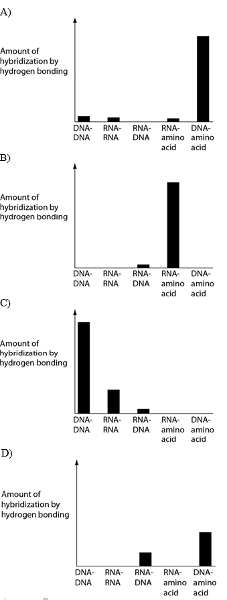
Several scientific laboratories across the globe are performing research concerning the origin of life on Earth. Suppose one of these laboratories conducts abiotic experiment(s) to test the potential for hydrogen bonding between various nucleic acids and amino acids. Which of the following results of such experiments are most consistent with our current understanding of Earth's first genetic systems?
A)
B)
C)
D)
B
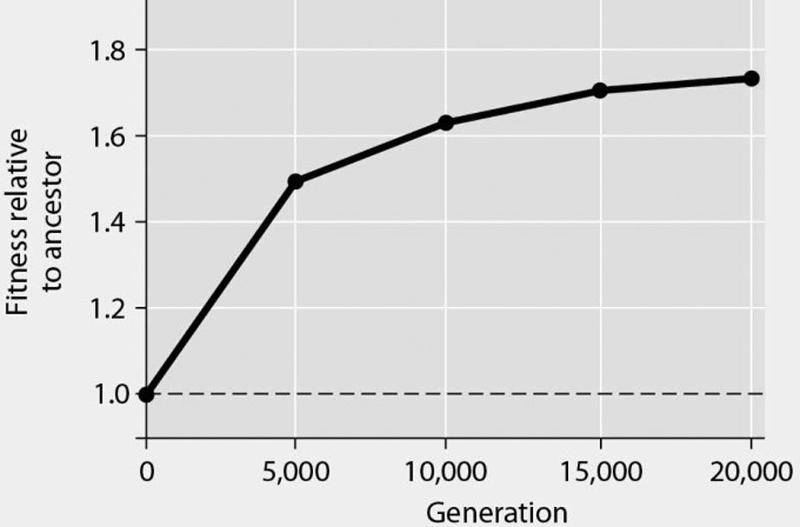
If the vertical axis of Figure 24.1 refers to "Darwinian fitness," then which of the following is the most valid and accurate measure of fitness?
- A) number of offspring or close kin that survive to reproductive age
- B) amount of ATP generated per cell per unit time
- C) average swimming speed of cells through the growth medium
- D) amount of glucose synthesized per unit time
- E) number of generations per unit time
A
If new genetic variation in the experimental populations arose solely by spontaneous mutations, then the most effective process for subsequently increasing the number of individuals that possess all of these beneficial mutations is
- A) transduction.
- B) binary fission.
- C) conjugation.
- D) transformation.
- E) meiosis.
B
- coli cells typically make most of their ATP by metabolizing glucose. Under the conditions of this experiment, what should be true of E. coli's generation time (especially early in the course of the experiment, but less so later on)?
- A) Generation time should be the same as in the typical environment.
- B) Generation time should be faster than in the typical environment.
- C) Generation time should be slower than in the typical environment.
- D) It is theoretically impossible to make any predictions about generation time under these conditions.
C
If the experimental population of E. coli lacks an F factor or F plasmid, and if bacteriophages are excluded from the bacterial cultures, then which of these is means by which beneficial mutations might be transmitted horizontally to other E. coli cells?
- A) via sex pili
- B) via transduction
- C) via conjugation
- D) via transformation
D
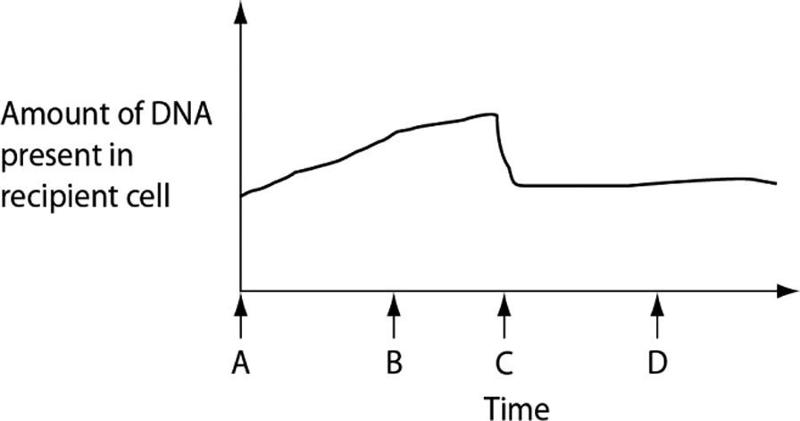
What is occurring at time C that is decreasing the DNA content?
- A) crossing over
- B) cytokinesis
- C) meiosis
- D) degradation of DNA that was not retained in the recipient's chromosome
- E) reversal of the direction of conjugation
D
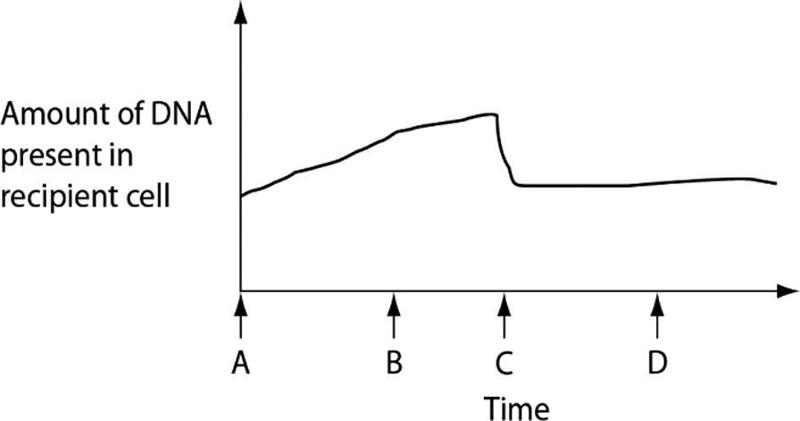
How is the recipient cell different at time D than it was at time A?
- A) It has a greater number of genes.
- B) It has a greater mass of DNA.
- C) It has a different sequence of base pairs.
- D) It contains bacteriophage DNA.
- E) Its membrane-bound DNA pumps are inactive.
C
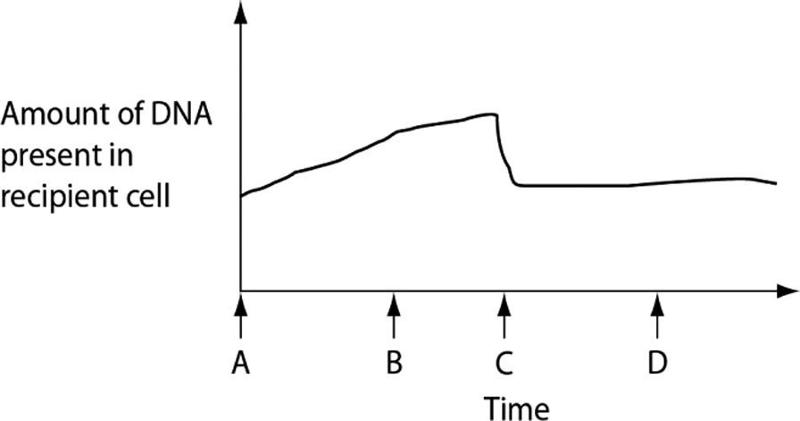
Which two processes are responsible for the shape of the curve at time B?
- transduction
- entry of single-stranded Hfr DNA
- rolling circle replication of single-stranded Hfr DNA
- conjugation
- A) 1 and 2
- B) 1 and 3
- C) 2 and 3
- D) 2 and 4
- E) 3 and 4
C
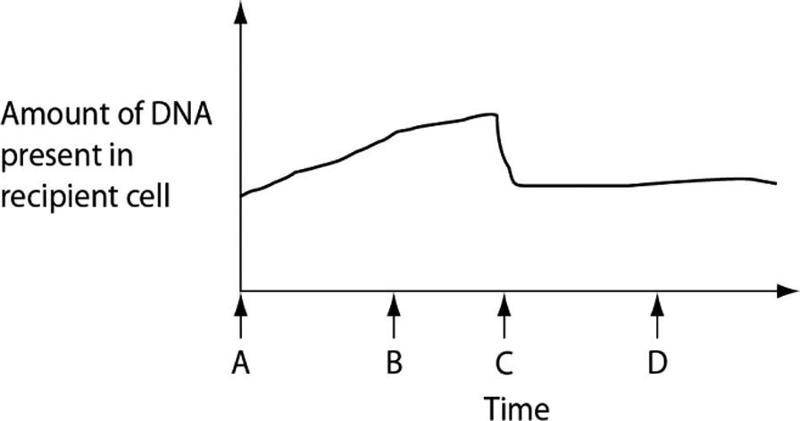
During which two times can the recipient accurately be described as "recombinant" due to the sequence of events portrayed in Figure 24.2?
- A) during times C and D
- B) during times A and C
- C) during times B and C
- D) during times A and B
- E) during times B and D
A
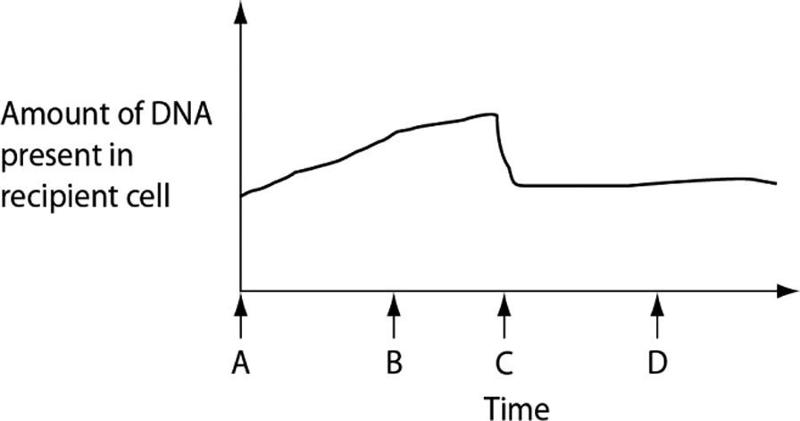
Which question arising from the results depicted in Figure 24.2 is most interesting from a genetic perspective and has the greatest potential to increase our knowledge base?
- A) If reciprocal crossing over could occur even if the piece of donated Hfr DNA is identical to the homologous portion of the recipient's chromosome, what prevents this from occurring?
- B) What forces are generally responsible for disrupting the sex pilus?
- C) How is it that a recipient cell does not necessarily become an Hfr cell as the result of conjugation with an Hfr cell?
- D) What makes a cell an Hfr cell?
A
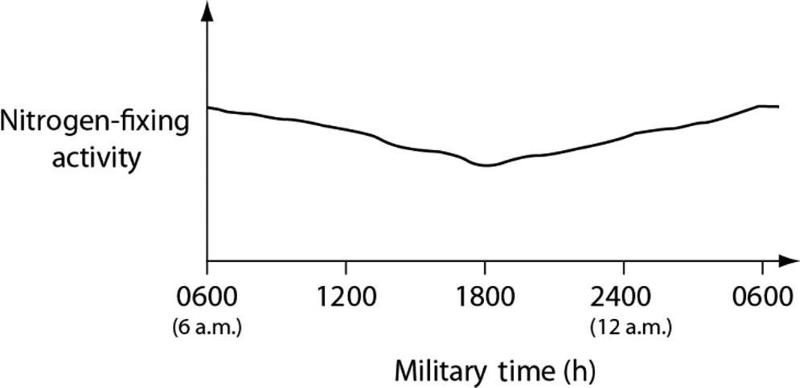
Data were collected from the heterocysts of a nitrogen-fixing cyanobacterium inhabiting equatorial ponds. Study the following figure and choose the most likely explanation for the shape of the curve.
- A) Enough O2enters heterocysts during hours of peak photosynthesis to have a somewhat-inhibitory effect on nitrogen fixation.
- B) Light-dependent reaction rates must be highest between 1800 hours and 0600 hours.
- C) Atmospheric N2levels increase at night because plants are no longer metabolizing this gas, so they are not absorbing this gas through their stomata.
- D) Heterocyst walls become less permeable to N2influx during darkness.
A

Which two species should have much more phospholipid, in the form of bilayers, in their cytoplasm than most other bacteria?
- A) species A and B
- B) species A and C
- C) species B and E
- D) species C and D
- E) species C and E
C

Which species should be able to respond most readily to taxes (plural of taxis)?
- A) species A
- B) species B
- C) species C
- D) species D
- E) species E
C

How many of these species probably have a cell wall that partly consists of an outer membrane of lipopolysaccharide?
- A) only one species
- B) two species
- C) three species
- D) four species
- E) all five species
C

Species D is pathogenic if it gains access to the human intestine. Which other species, if it coinhabited a human intestine along with species D, is most likely to result in a recombinant species that is both pathogenic and resistant to some antibiotics?
- A) species A
- B) species B
- C) species C
- D) species D
- E) species E
C

Which species is most self-sustaining in terms of obtaining nutrition in environments containing little fixed nitrogen or carbon?
- A) species A
- B) species B
- C) species C
- D) species D
- E) species E
E

Which two species might be expected to cooperate metabolically, perhaps forming a biofilm wherein one species surrounds cells of the other species?
- A) species A and B
- B) species A and C
- C) species B and E
- D) species C and D
- E) species C and E
A

Which species is most likely to be found both in sewage treatment plants and in the guts of cattle?
- A) species A
- B) species B
- C) species C
- D) species D
- E) species E
B

Which species is probably an important contributor of organic compounds such as sugars, which are then passed up through aquatic food chains?
- A) species A
- B) species B
- C) species C
- D) species D
- E) species E
E
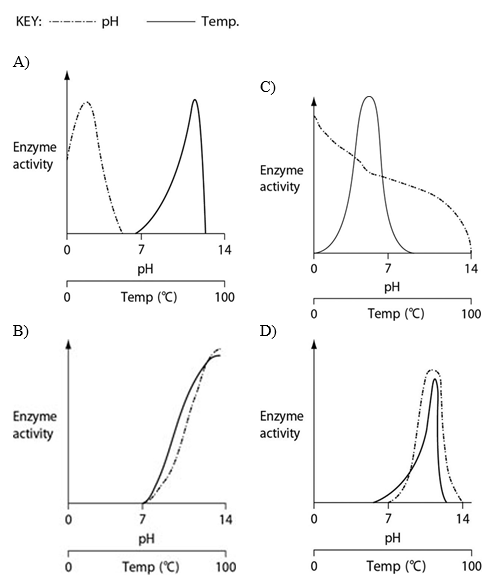
Thermoacidophiles are archaeans that are able to successfully live and reproduce in environments that are acidic, have high sulfur content and temperatures, and have little organic material. Consider the thermoacidophile Sulfolobus acidocaldarius. Which of the following graphs most accurately depicts the expected temperature and pH profiles of its enzymes? (Note: The horizontal axes of these graphs are double, with pH above and temperature below.)
A)
B)
C)
D)
A
The following question(s) are based on the observation that several dozen different proteins comprise the prokaryotic flagellum and its attachment to the prokaryotic cell, producing a highly complex structure.
1) If the complex protein assemblage of the prokaryotic flagellum arose by the same general processes as those of the complex eyes of molluscs (such as squids and octopi), then
- A) natural selection cannot account for the rise of the prokaryotic flagellum.
- B) ancestral versions of this protein assemblage were either less functional or had different functions than modern prokaryotic flagella.
- C) scientists should accept the conclusion that neither eyes nor flagella could have arisen by evolution.
B
Certain proteins of the complex motor that drives bacterial flagella are modified versions of proteins that had previously belonged to plasma membrane pumps. This evidence supports the claim that
- A) some structures are so complex that natural selection cannot, and will not, explain their origins.
- B) the power of natural selection allows it to act in an almost predictive fashion, producing organs that will be needed in future environments.
- C) the motors of bacterial flagella were originally synthesized abiotically.
- D) structures originally adapted for one purpose can take on new functions through descent with modification.
- E) bacteria that possess flagella must have lost the ability to pump certain chemicals across their plasma membranes.
D
A hypothetical bacterium swims among human intestinal contents until it finds a suitable location on the intestinal lining. It adheres to the intestinal lining using a feature that also protects it from bacteriophages and dehydration. Fecal matter from a human in whose intestine this bacterium lives can spread the bacterium, even after being mixed with water and boiled. The bacterium is not susceptible to the penicillin family of antibiotics. It contains no plasmids and relatively little peptidoglycan.
This bacterium's ability to survive in a human who is taking penicillin pills may be due to the presence of which of the following?
- penicillin-resistance genes
- a gram-positive cell wall
- a gram-negative cell wall
- an endospore
- A) 1 or 4
- B) 1 or 3
- C) 2 or 4
- D) 3 or 4
D
A hypothetical bacterium swims among human intestinal contents until it finds a suitable location on the intestinal lining. It adheres to the intestinal lining using a feature that also protects it from bacteriophages and dehydration. Fecal matter from a human in whose intestine this bacterium lives can spread the bacterium, even after being mixed with water and boiled. The bacterium is not susceptible to the penicillin family of antibiotics. It contains no plasmids and relatively little peptidoglycan.
Adherence to the intestinal lining by this bacterium is due to its possession of
- A) fimbriae.
- B) pili.
- C) a capsule.
- D) a flagellum.
- E) a cell wall with an outer lipopolysaccharide membrane.
C
A hypothetical bacterium swims among human intestinal contents until it finds a suitable location on the intestinal lining. It adheres to the intestinal lining using a feature that also protects it from bacteriophages and dehydration. Fecal matter from a human in whose intestine this bacterium lives can spread the bacterium, even after being mixed with water and boiled. The bacterium is not susceptible to the penicillin family of antibiotics. It contains no plasmids and relatively little peptidoglycan.
What should be true of the cell wall of this bacterium?
- A) Its innermost layer is composed of a phospholipid bilayer.
- B) After it has been subjected to Gram staining, the cell should remain purple.
- C) It has an outer membrane of lipopolysaccharide.
- D) It is mostly composed of a complex, cross-linked polysaccharide.
- E) Two of the responses above are correct.
C
A hypothetical bacterium swims among human intestinal contents until it finds a suitable location on the intestinal lining. It adheres to the intestinal lining using a feature that also protects it from bacteriophages and dehydration. Fecal matter from a human in whose intestine this bacterium lives can spread the bacterium, even after being mixed with water and boiled. The bacterium is not susceptible to the penicillin family of antibiotics. It contains no plasmids and relatively little peptidoglycan.
In which feature(s) should one be able to locate a complete chromosome of this bacterium?
- nucleolus
- pili
- endospore
- nucleoid
- A) 4 only
- B) 1 and 3
- C) 2 and 3
- D) 3 and 4
- E) 2, 3, and 4
D
A hypothetical bacterium swims among human intestinal contents until it finds a suitable location on the intestinal lining. It adheres to the intestinal lining using a feature that also protects it from bacteriophages and dehydration. Fecal matter from a human in whose intestine this bacterium lives can spread the bacterium, even after being mixed with water and boiled. The bacterium is not susceptible to the penicillin family of antibiotics. It contains no plasmids and relatively little peptidoglycan.
The cell also lacks F factors and F plasmids. Which mechanism(s) of genetic recombination can possibly take place?
- conjugation
- transduction
- transformation
- A) 1 only
- B) 2 only
- C) 3 only
- D) 2 and 3
D
A hypothetical bacterium swims among human intestinal contents until it finds a suitable location on the intestinal lining. It adheres to the intestinal lining using a feature that also protects it from bacteriophages and dehydration. Fecal matter from a human in whose intestine this bacterium lives can spread the bacterium, even after being mixed with water and boiled. The bacterium is not susceptible to the penicillin family of antibiotics. It contains no plasmids and relatively little peptidoglycan.
This bacterium derives nutrition by digesting human intestinal contents (in other words, food). Thus, this bacterium should be an
- A) aerobic chemoheterotroph.
- B) aerobic chemoautotroph.
- C) anaerobic chemoheterotroph.
- D) anaerobic chemoautotroph.
C
A hypothetical bacterium swims among human intestinal contents until it finds a suitable location on the intestinal lining. It adheres to the intestinal lining using a feature that also protects it from bacteriophages and dehydration. Fecal matter from a human in whose intestine this bacterium lives can spread the bacterium, even after being mixed with water and boiled. The bacterium is not susceptible to the penicillin family of antibiotics. It contains no plasmids and relatively little peptidoglycan.
This bacterium derives nutrition by digesting human intestinal contents (in other words, food). Humans lacking this bacterium have no measurable reproductive advantage or disadvantage relative to humans who harbor this bacterium. Consequently, the bacterium can be properly described as which of the following?
- symbiont
- endotoxin
- mutualist
- commensal
- A) 4 only
- B) 1 and 2
- C) 1 and 4
- D) 2 and 3
- E) 2 and 4
C
Nitrogenase, the enzyme that catalyzes nitrogen fixation, is inhibited whenever free O2 reaches a critical concentration. Consequently, nitrogen fixation cannot occur in cells wherein photosynthesis produces free O2. Consider the colonial aquatic cyanobacterium Anabaena, whose heterocytes are described as having "a thickened cell wall that restricts entry of O2 produced by neighboring cells. Intracellular connections allow heterocysts to transport fixed nitrogen to neighboring cells in exchange for carbohydrates."
Given that the enzymes that catalyze nitrogen fixation are inhibited by oxygen, what are two "strategies" that nitrogen-fixing prokaryotes might use to protect these enzymes from oxygen?
- package them in membranes that are impermeable to all gases
- be obligate anaerobes
- be facultative aerobes
- package these enzymes in specialized cells or compartments that inhibit oxygen entry
- A) 1 and 4
- B) 2 and 4
- C) 2 and 3
- D) 3 and 4
B
Which two of the following questions arise from a careful reading of this quotation and are most important for understanding how N2 enters heterocysts and how O2 is kept out of heterocysts?
- If carbohydrates can enter the heterocysts from neighboring cells via the "intracellular connections," how is it that O2doesn't also enter via this route?
- If the cell walls of Anabaena's photosynthetic cells are permeable to O2and CO2, are they also permeable to N2?
- If the nuclei of the photosynthetic cells contain the genes that code for nitrogen fixation, how can these cells fail to perform nitrogen fixation?
- If the nuclei of the heterocysts contain the genes that code for photosynthesis, how can these cells fail to perform photosynthesis?
- If the cell walls of Anabaena's heterocysts are permeable to N2, how is it that N2doesn't diffuse out of the heterocysts before it can be fixed?
- If the thick cell walls of the heterocysts exclude entry of oxygen gas, how is it that they don't also exclude the entry of nitrogen gas?
- A) 1 and 3
- B) 1 and 6
- C) 2 and 5
- D) 3 and 4
- E) 4 and 6
B
Which of the following steps has not yet been accomplished by scientists studying the origin of life?
- A) synthesis of small RNA polymers by ribozymes
- B) abiotic synthesis of polypeptides
- C) formation of molecular aggregates with selectively permeable membranes
- D) formation of protocells that use DNA to direct the polymerization of amino acids
D
Fossilized stromatolites
- A) more than 2.8 billion years old have not been discovered.
- B) formed around deep-sea vents.
- C) resemble structures formed by bacterial communities that are found today in some shallow marine bays.
- D) provide evidence that photosynthesis was occurring in the oceans by 2.5 billion years ago.
C
Genetic variation in bacterial populations cannot result from
- A) meiosis.
- B) transformation.
- C) transduction.
- D) mutation.
A
Photoautotrophs use
- A) light as an energy source and methane as a carbon source.
- B) light as an energy source and CO2as a carbon source.
- C) H2S as an energy source and CO2as a carbon source.
- D) CO2as both an energy source and a carbon source.
B
Which of the following statements is not true?
- A) Archaea and bacteria have different membrane lipids.
- B) The cell walls of archaea lack peptidoglycan.
- C) Only bacteria have histones associated with DNA.
- D) Only some archaea use CO2to oxidize H2, releasing methane.
C
Bacteria participate in many ecological interactions. Which role typically does not involve symbiosis?
- A) living as commensalists on the skin of humans
- B) providing bioluminescence in fish
- C) digesting food as mutualists in animal intestines
- D) decomposing dead organisms and organic wastes
D
Plantlike photosynthesis that releases O2 occurs in
- A) cyanobacteria.
- B) chlamydias.
- C) archaea.
- D) chemoautotrophic bacteria.
A